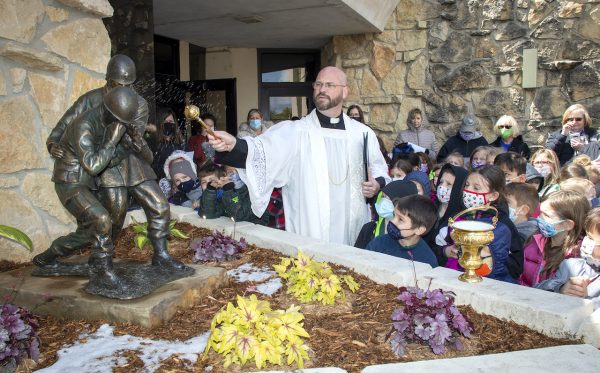Fr. Kapaun statue blessed

Fr. Jarrod Lies blesses a statue of Fr. Emil Kapaun April 20, 2021, at St. Francis of Assisi Church in Wichita, Kansas.
An original bronze statue of Father Emil Kapaun helping a fellow soldier off the battlefield was blessed Tuesday, April 20, at St. Francis of Assisi Parish in Wichita.
Almost 200 students and parishioners attended the unveiling and blessing on what would have been Fr. Kapaun’s 105th birthday. He died on May 23, 1951.
Before the blessing, Father Jarrod Lies talked about the unusual snow that morning and related it to the arctic conditions Fr. Kapaun and his fellow soldiers endured in their North Korean prisoner-of-war camp.
“They reported temperatures of 30 to 40 degrees below zero,” he said. “It was the coldest winter in Korea in 150 years.”
About the artist
Fr. Lies told those gathered around him about Lynn Kircher, the artist, and explained how the statue was produced. He said the statue was commissioned through the generosity of several anonymous donors and gave details about how the final depiction was chosen.
“It’s the only statue of its kind,” he said. “This is an incredibly important piece for us because very few of our statues on this campus are handmade.”
After commenting on the details of the statue, he suggested that those pondering the sculpture think about how God helps us when we are injured, when we’re on a ‘battlefield,’ or when we’re in danger.
Before the blessing ceremony Fr. Lies asked those attending to ask for Fr. Kapaun’s intercession and to pray for his cause for canonization.
Background history
Harriet Rosa, a parish secretary who helped coordinate the process, said several generous parishioners came forward last summer regarding the possible commission of a statue honoring the diocesan native son.
Lynn Kircher, an artist from Jaroso, Colorado, was commissioned after several artists were interviewed, she said. Other pieces sculpted by Kircher are at Church of the Magdalen in Wichita and St. Mary Church in Derby.
“The statue is loosely based on a photo of Fr. Kapaun carrying a wounded soldier,” Rosa said.
The process began with sketches sent back and forth between Kircher and the parish. After a sketch was approved, the artist sculpted and modified a maquette, a scale model of the statue according to parish wishes. When that was done a full-scale, three-foot-tall statue was sculpted for approval.
“Every step of the way has been quite a process,” she said. “He had models come in so he could see how the clothing would fall and how he would look carrying the soldier,” she said. “We’re very pleased with the amount of detail.”
The statue is based on a photograph taken of Fr. Kapaun carrying a wounded soldier during their 60-mile march to a prisoner-of-war camp.
Fr. Kapaun’s helmet and the stole, which Rosa said was the result of artistic license, are shinier than the other parts of the statue to emphasize that he was a chaplain.
All invited to visit, pray
“We’re hoping that people from all over the diocese can use this as a place of comfort and to remember veterans and honor Fr. Kapaun.”
The outdoor statue is at the north entrance of the church, near the bell tower. It can be visited at any time.
Fr. Kapaun was born in 1916 and was raised in the small farming community of Pilsen, Kansas. He was ordained a diocesan priest in 1940 and eventually served as a U.S. Army chaplain during World War II and the Korean War.
In 1950, while serving in the Korean War, Fr. Kapaun was captured with others from his regiment and marched to a prison camp where he spent the last months of his life heroically serving his fellow prisoners.
Fr. Kapaun’s cause for canonization was initiated in 1993 and presented to the Vatican’s Congregation for Saints in 2015. Due to his life of courageous virtue and his roots in the Diocese of Wichita, St. Francis chose to honor him with a bronze sculpture on the south side of the church.
It was recently announced by the Diocese of Wichita that Fr. Kapaun’s remains had been identified. They will be moved from a burial site in Hawaii to Wichita in the next several months. A crypt in the Cathedral of the Immaculate Conception in Wichita is planned to hold the remains.
